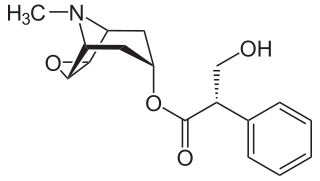
Tiotixene, or thiothixene, sold under the brand name Navane among others, is a typical antipsychotic of the thioxanthene class which is related to chlorprothixene and is used in the treatment of psychoses like schizophrenia and bipolar mania. It was introduced in the United States in 1967 by Pfizer.

Histamine H3 receptors are expressed in the central nervous system and to a lesser extent the peripheral nervous system, where they act as autoreceptors in presynaptic histaminergic neurons and control histamine turnover by feedback inhibition of histamine synthesis and release. The H3 receptor has also been shown to presynaptically inhibit the release of a number of other neurotransmitters (i.e. it acts as an inhibitory heteroreceptor) including, but probably not limited to dopamine, GABA, acetylcholine, noradrenaline, histamine and serotonin.

The histamine H4 receptor, like the other three histamine receptors, is a member of the G protein-coupled receptor superfamily that in humans is encoded by the HRH4 gene.

Alcuronium chloride is a neuromuscular blocking (NMB) agent, alternatively referred to as a skeletal muscle relaxant. It is a semi-synthetic substance prepared from C-toxiferine I, a bis-quaternary alkaloid obtained from Strychnos toxifera. C-toxiferine I itself has been tested for its pharmacological action and noted to be a very long acting neuromuscular blocking agent For a formal definition of the durations of actions associated with NMB agents, see page for gantacurium. The replacement of both the N-methyl groups with N-allyl moieties yielded N,N-diallyl-bis-nortoxiferine, now recognized as alcuronium.

Cipralisant (GT-2331, tentative trade name Perceptin) is an extremely potent histamine H3 receptor ligand originally developed by Gliatech. Cipralisant was initially classified as a selective H3 antagonist, but newer research (2005) suggests also agonist properties, i. e. functional selectivity. Cipralisant seemed to be well tolerated during early testing, entering Phase II trials for ADHD in 2000.

Ciproxifan is an extremely potent histamine H3 inverse agonist/antagonist.

A muscarinic receptor antagonist (MRA) is a type of anticholinergic agent that blocks the activity of the muscarinic acetylcholine receptor. The muscarinic receptor is a protein involved in the transmission of signals through certain parts of the nervous system, and muscarinic receptor antagonists work to prevent this transmission from occurring. Notably, muscarinic antagonists reduce the activation of the parasympathetic nervous system. The normal function of the parasympathetic system is often summarised as "rest-and-digest", and includes slowing of the heart, an increased rate of digestion, narrowing of the airways, promotion of urination, and sexual arousal. Muscarinic antagonists counter this parasympathetic "rest-and-digest" response, and also work elsewhere in both the central and peripheral nervous systems.

Antihistamines are drugs which treat allergic rhinitis, common cold, influenza, and other allergies. Typically, people take antihistamines as an inexpensive, generic drug that can be bought without a prescription and provides relief from nasal congestion, sneezing, or hives caused by pollen, dust mites, or animal allergy with few side effects. Antihistamines are usually for short-term treatment. Chronic allergies increase the risk of health problems which antihistamines might not treat, including asthma, sinusitis, and lower respiratory tract infection. Consultation of a medical professional is recommended for those who intend to take antihistamines for longer-term use.

The glutamate receptor, metabotropic 1, also known as GRM1, is a human gene which encodes the metabotropic glutamate receptor 1 (mGluR1) protein.
An H3 receptor antagonist is a classification of drugs used to block the action of histamine at the H3 receptor.

Perzinfotel (EAA-090) is a drug which acts as a potent NMDA antagonist. It has neuroprotective effects and has been investigated for the treatment of stroke, but lacks analgesic effects. Nevertheless, it shows a good safety profile compared to older drugs, although further development of this drug has been discontinued.

A-349,821 is a potent and selective histamine H3 receptor antagonist (or possibly an inverse agonist). It has nootropic effects in animal studies, although there do not appear to be any plans for clinical development at present and it is currently only used in laboratory research.

JNJ-7777120 was a drug being developed by Johnson & Johnson Pharmaceutical Research & Development which acts as a potent and selective antagonist at the histamine H4 receptor. It has anti-inflammatory effects, and has been demonstrated to be superior to traditional (H1) antihistamines in the treatment of pruritus (itching). The drug was abandoned because of its short in vivo half-life and hypoadrenocorticism toxicity in rats and dogs, that prevented advancing it into clinical studies.

4-Methylhistamine is a histamine agonist selective for the H4 subtype.
GSK-189,254 is a potent and selective H3 histamine receptor inverse agonist developed by GlaxoSmithKline. It has subnanomolar affinity for the H3 receptor (Ki = 0.2nM) and selectivity of over 10,000x for H3 over other histamine receptor subtypes. Animal studies have shown it to possess not only stimulant and nootropic effects, but also analgesic action suggesting a role for H3 receptors in pain processing in the spinal cord. GSK-189,254 and several other related drugs are currently being investigated as a treatment for Alzheimer's disease and other forms of dementia, as well as possible use in the treatment of conditions such as narcolepsy, or neuropathic pain which do not respond well to conventional analgesic drugs.

Proxyfan is a histamine H3 receptor ligand which is a "protean agonist", producing different effects ranging from full agonist, to antagonist, to inverse agonist in different tissues, depending on the level of constitutive activity of the histamine H3 receptor. This gives it a complex activity profile in vivo which has proven useful for scientific research.

A-423,579 is one of a range of histamine antagonists developed by Abbott Laboratories which are selective for the H3 subtype, and have stimulant and anorectic effects in animal studies making them potentially useful treatments for obesity. A-423,579 has improved characteristics over earlier drugs in the series with both high efficacy and low toxicity in studies on mice, and is currently in clinical development.

3-( ethynyl)pyridine (MTEP) is a research drug that was developed by Merck & Co. as a selective allosteric antagonist of the metabotropic glutamate receptor subtype mGluR5. Identified through structure-activity relationship studies on an older mGluR5 antagonist MPEP, MTEP has subsequently itself acted as a lead compound for newer and even more improved drugs.
UR-AK49 is a drug used in scientific research which acts as a potent antagonist for the Neuropeptide Y / Pancreatic polypeptide receptor Y4, and also as a partial agonist at the histamine receptors H1 and H2. UR-AK49 is a pure antagonist at Y4 with no partial agonist effects, and although it is only slightly selective for Y4 over the related Y1 and Y5 receptors, as the first non-peptide Y4 antagonist developed UR-AK49 is expected to be useful in the study of this receptor and its role in the body.

Clorotepine, also known as octoclothepin or octoclothepine, is an antipsychotic of the tricyclic group which was derived from perathiepin in 1965 and marketed in the Czech Republic by Spofa in or around 1971 for the treatment of schizophrenic psychosis.

















